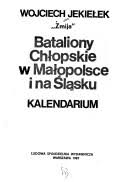Polokaust Palliation By Polish Guerrillas. Stop Holocaust Railroads Myth Debunked. Jekielek

Bataliony Chlopskie w Malopolsce i Na Slasku, by Wojciech Jekielek. 1987
Polish Guerrillas Counter the German-Sponsored Alcoholism, Confiscations of Feedstuffs, and Polish Collaborators. The Mythical Possibility of Death-Camp-Bound Trains Destroyed By the Polish Underground
Title: THE PEASANT BATTALIONS IN THE MALOPOLSKA REGION AND IN SILESIA: A CALENDAR.
This work follows a diary format. Each page consists of separate paragraphs demarcated dates of occurrence.
HOLOCAUST-RELATED ACCUSATIONS: THE FANTASY OF STOPPING RAIL TRANSPORT TO THE GERMAN EXTERMINATION CAMPS
Complaints about the Polish Underground not interdicting the shipment of Jews to the death camps are out of touch with reality. To begin with, Polish guerillas weren’t significantly deployed until late 1942, by which time most Polish Jews had already been murdered. (In fact, in this work, there are only 21 pages of entries for 1941-1942, in contrast to 278 pages covering 1943-1945.).
Though the BCh did enjoy some successes in raiding German trains for weaponry (p. 35, 48), these were sporadic owing to the ever-present BAHNSCHUTZ (German railroad security police.). Finally, even the rare spectacular successes in unscrewing tracks to cause derailments, or blowing up of train cars, only halted German rail traffic, and then only at that specific location, for a mere 12-24 hours! (p. 67, 130, 221).
DEALING WITH POLISH COLLABORATORS
Poles collaborating with Germans were shot, including certain members of the Blue Police (POLICJA GRANATOWA)(p. 19, 27-28, 47, 169, 175), and Poles who served as Gestapo informers–often for money. (p. 32, 38-42, 47, 56, 60, 70, 71, 73, 79, 82-83, 103, 106, 116, 119, 123, 126, 130, 145, 149, 154, 169, 170, 246, 284, 290). These agents undoubtedly included Poles who denounced fugitive Jews, some of whom are explicitly condemned for doing so. (p. 70, 79, 169).
THE CANARD OF A POLISH “HEROIC NARRATIVE” PREVENTING POLES ACCEPTING THE FACT OF SOME POLES COLLABORATING WITH THE NAZIS
The foregoing entries add to the refutation of the premise that “Polish nationalists” are too proud to discuss ignoble Polish deeds, and the claim that the Polish Underground did next to nothing to eliminate Polish betrayers of fugitive Jews. The BCh also aided Jews in other ways. (p. 28, 368). It is high time that the Jewish (and LEWAK) critics of the “Polish Heroic Narrative” and “Poland Jesus Christ of nations” give this canard a rest.
THE DAILY ATTEMPTS TO PALLIATE THE GENOCIDAL GERMAN TERROR
This work differs from many others in that, instead of focusing on Polish guerrilla combat encounters with the German enemy, it emphasizes the role of the BCh in maintaining social discipline in spite of the brutalities of the German occupation. For instance, Polish women who consorted with Germans were head-shaven. Poles deemed too diligent in their obedience to German commands were warned or beaten, as were Poles who defrauded or stole from other Poles. [Obviously, this was an all-around war-situational problem, and not, as portrayed in Holocaust materials, as just something that those big, bad “Poles did to Jews”.]
REDUCING THE SEVERITY OF THE GERMAN PILLAGE OF POLISH AGRICULTURAL PRODUCTS
To interfere with the Germans’ requisitioning system, the BCh frequently attacked village record-keeping centers. (p. 46, 49, 59, 64, 68, 73, 96, 122, 183). Confiscated livestock were sometimes successfully scattered. (p. 60, 131, 205).
THE POLOKAUST AND GERMAN ATTEMPTS TO DESTROY THE CONQUERED POLES THROUGH ALCOHOLISM
The Germans promoted alcoholism among the Polish people as part of their long-term strategy to destroy them (as noted by Raphael Lemkin, the Polish Jew who coined the term genocide.) The BCh attacked German alcohol-dispensing centers (p. 113, 265) and relentlessly destroyed stocks of liquor and moonshine stills, subjecting their owners to reprimands, fines, and beatings. (p. 25, 29, 30, 33, 37, 40, 57, 88, 90, 102, 104, 119, 120, 124, 127, 142, 237, 238, 271).
JUDICIOUS GUERRILLA COMBAT AGAINST THE GERMAN OCCUPATION FORCES
The BCh attacked the confiscated Polish properties given to newcomer German settlers. (p. 19, 34, 136, 143). To minimize collective reprisals against Poles, armed Germans were usually released after disarming, and the BCh didn’t engage the German forces on a large scale until the near-arrival of the Red Army. Up to that time, only exceptionally sadistic Germans were assassinated, and the BCh fought openly only when encircled, or in defense of villages during German “pacification” campaigns. (e. g, p. 90, 174, 184).
SELECTIVE, PROTECTIVE REPRISALS AGAINST UKRAINIAN GENOCIDAL TERROR
Ukrainians were targeted not collectively but as individuals: Nazi collaborators, OUN members, etc. (p. 37, 50, 63, 65, 69, 87, 95, 101, 123, 135, 144, 148, 163, 193, 196, 250, 253, 266-267), and in defense against genocidal attacks by the fascist-separatist OUN-UPA (p. 137) and the Ukrainian SS. (p. 190). A Ukrainian priest, “H.” from Dubieck, was assassinated for delivering sermons that encouraged Ukrainians to murder Poles. (p. 141).
To see a series of truncated reviews in a Category click on that Category:
- All reviews
- Anti-Christian Tendencies
- Anti-Polish Trends
- Censorship on Poles and Jews
- Communization of Poland
- Cultural Marxism
- German Guilt Dilution
- Holocaust Industry
- Interwar Polish-Jewish Relations
- Jewish Collaboration
- Jewish Economic Dominance
- Jews Antagonize Poland
- Jews Not Faultless
- Jews' Holocaust Dominates
- Jews' Holocaust Non-Special
- Nazi Crimes and Communist Crimes Were Equal
- Opinion-Forming Anti-Polonism
- Pogrom Mongering
- Poland in World War II
- Polish Jew-Rescue Ingratitude
- Polish Nationalism
- Polish Non-Complicity
- Polish-Ukrainian Relations
- Polokaust
- Premodern Poland
- Recent Polish-Jewish Relations
- The Decadent West
- The Jew as Other
- Understanding Nazi Germany
- Why Jews a "Problem"
- Zydokomuna